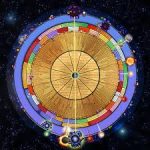Avasthas are the classifications of a planet based on the state of the planet. A planet has an Avastha given based on the degree of the planet within a particular Rashi. The ancient text Brihat Parashara Hora Shastra gives us detailed explanations and calculations by which we can quantify the state of the planet and also precisely predict the planet’s results.
The Basic Avasthas
The planets are classified into states that range from infancy to deceased based on the degrees of the planet within a Rashi. Every Rashi spans 30 degrees. These 30 degrees are divided into 5 sections of 6 degrees each. For the odd Rashis the 5 Avasthas allocated to these sections are Bala (infant), Kumara (youthful), Yuva (adolescent), Vridha (advanced) and then Mrita (deceased). For the even Rashis this order is reversed.

| Degree | Odd Rashi | Even Rashi |
| 0 degrees to 6 degrees | Balavastha | Mritavastha |
| 6 degrees to 12 degrees | Kumaravastha | Vridhavastha |
| 12 degrees to 18 degrees | Yuvavastha | Yuvavastha |
| 18 degrees to 24 degrees | Vridhavastha | Kumaravastha |
| 24 degrees to 30 degrees | Mritavastha | Balavastha |
The results that the planets give are directly linked to the Avastha of the planet. A planet that is in Yuvavastha or adolescent stage gives full results, ¼ in Balavastha, ½ in Kumaravastha, very little in Vridhavastha and none in Mritavastha.
State Of Being Awake
There is another set of states that the planet is assigned based on the Rashi that the planet is in. When the planet is in its own sign or sign of exaltation, it is said to be awake. A planet in a neutral sign or a friendly sign is in a dreaming state. In an enemy’s house or in debilitation, it is in a sleeping state. The result is full when awake, medium when dreaming and none when asleep.

Nine More States
There are nine other states of the planets, namely; Deepta, Swastha, Pramudita, Shanta, Deena, Dukhita, Vikala, Khala and Kopa
Deeptavastha: A planet in exaltation is in Deeptavastha. This is an auspicious and excellent position.
Swasthavastha: A planet in its own house is also said to be in a good and auspicious placement.
Pramuditavastha: A planet in a very good friend’s house is good and also auspicious.
Shantavastha: In a friend’s house the planet gives only medium results.
Deenavastha: In a neutral house also the results are medium.
Dukhitavasthas: In enemy’s house also gives very little results.
Vikalavastha: Planet conjunct with a malefic also gives negligible results.
Khalavastha: Planet in an inauspicious sign also gives negligible effects.
Kopavastha: Planet conjunct with the Sun is also said to give little or negligible results.
Other Avasthas
The other Avasthas that are defined for planets are the Lajitta, Garvita, Kshuditha, Trashita, Mudita and Kshobita.
Lajjitavastha is when the planet is in the 5th house of the chart with either Rahu or Ketu or a planet conjunct with Saturn Or Mars is said to be in Lajjitavastha.
A planet either in exaltation or Moolatrikona is in Garvitavastha. In an enemy’s sign with the aspect and conjunction of an enemy is in Kshuditavastha. Kshobitavastha is when the planet is in conjunction with the Sun and aspected by an enemy and also by a malefic. Both the Kshuditavastha and the Kshobithavastha destroy the houses in which they are. Conjunction with Saturn also amounts to the same. When a planet is in a water sign and aspected by an enemy with no benefic aspect is in Trashitavastha. Placement in a friend’s sign with Jupiter and receiving the aspect or in conjunction with a friend is in Muditavastha.

How To Use Avasthas
The Avasthas should be taken into consideration to interpret the effects of the planet. The Avasthas give an indication of the strengths and also weaknesses of the planet. Naturally, a planet that is in a good Avastha is strong to give better effects while one that is in a weak Avastha gives poor results. When a planet that is in Lajittavastyha, Trashitavastha, Kshuditavastha or Kshobitavastha in the 10th house the person will have much misery in life.
When there is a Lajittavastha planet in the 5th house of the person, they will lose a son but will have one son. A planet in the Lajittavastha gives loss of intelligence, dislike of religion, interest in bad things and aversion to good as well as a disease to the son. When the seventh house has a Kshobithavastha and Trashitavastha planet, the person loses the spouse at an early age. A planet that is in Kshobitavastha gives troubles with severe penury, misery, financial issues, income issues because of the government and health issues with the feet. Planet that is in Kshudithavastha gives sorrow on account of relatives, grief, extreme emotions, enemies, poor finances and loss of physical health and thinking. The planet that is in Trashitavastha gives health issues caused by association with women, wicked actions, loss of money because of family issues, loss of honour, and physical weakness.
Garvitavastha
A planet in Garvitavastha blesses the person with happiness, houses, gardens, financial and business gains. The planet in the Mudiavastha blesses the person with luxuries, fine clothes, ornaments, homes, land, marital happiness, destruction of enemies and great wisdom and knowledge.

Nirdra And Chesta Avasthas
There are two states of waking and sleeping called the Chestha and Nidra Avasthas. The different types of these Avasthas are Shayana, Upaveshana, Netrapani, Prakashana, Gamana, Agamana, Sabhavastha Agama, Bhojana, Nrityalipsa, Kautuka as well as Nidra. This state of a planet is calculated using a formula.
Take the list of Nakshatras and determine the serial number of the Nakshatra in which the planet is placed.
| No. | Nakshatra | Lord |
| 1 | Ashwini | Ketu |
| 2 | Bharani | Venus |
| 3 | Krittika | Sun |
| 4 | Rohini | Moon |
| 5 | Mrigashirsha | Mars |
| 6 | Ardra | Rahu |
| 7 | Punarvasu | Jupiter |
| 8 | Pushya | Saturn |
| 9 | Ashlesha | Mercury |
| 10 | Magha | Ketu |
| 11 | Purvaphalguni | Venus |
| 12 | Uttaraphalguni | Sun |
| 13 | Hasta | Moon |
| 14 | Chitra | Mars |
| 15 | Swati | Rahu |
| 16 | Vishakha | Jupiter |
| 17 | Anuradha | Saturn |
| 18 | Jyeshta | Mercury |
| 19 | Mula | Ketu |
| 20 | Purvashadha | Venus |
| 21 | Uttarashadha | Sun |
| 22 | Shravana | Moon |
| 23 | Dhanistha | Mars |
| 24 | Shatabhishak | Rahu |
| 25 | Purvabhadrapada | Jupiter |
| 26 | Uttarabhadrapada | Saturn |
| 27 | Revati | Mercury |
Step 2: The serial number of the planet is determined.
| No. | Planet |
| 1 | Sun |
| 2 | Moon |
| 3 | Mars |
| 4 | Mercury |
| 5 | Jupiter |
| 6 | Venus |
| 7 | Saturn |
| 8 | Rahu |
| 9 | Ketu |
Step 3: Each Rashi is divided into 9 sections of 3 degrees and 20 minutes each which is the basis of the Navamsa. If we give these sections serial numbers we can then determine the Navamsa number of the planet.
| No. | Navamsa |
| 1 | 0 degrees to 3 degrees 20 minutes |
| 2 | 3 degrees 21 minutes to 6 degrees 40 minutes |
| 3 | 6 degrees 41 minutes to 10 degrees |
| 4 | 10 degrees 1 minute to 13 degrees 20 minutes |
| 5 | 13 degrees 21 minutes to 16 degrees 40 minutes |
| 6 | 16 degrees 41 minutes to 20 degrees |
| 7 | 20 degrees 1 minute to 23 degrees 20 minutes |
| 8 | 23 degrees 21 minutes to 26 degrees 40 minutes |
| 9 | 26 degrees 41 minutes to 30 degrees |
Next
Step 4: The serial number of the Janma Nakshatra (the Nakshatra in which the Moon is placed in the birth chart)
Ishta Ghati
Step 5: The Ishta Ghati of the time of birth which is calculated by the difference between the time of sunrise and the birth time multiplied by 2.5. If there is a Vighati then this number is added to 1.
Step 6: The serial number of the ascendant Rashi.
| No. | Rashi |
| 1 | Mesha/Aries |
| 2 | Rishaba/Taurus |
| 3 | Mithuna/Gemini |
| 4 | Kartaka/Cancer |
| 5 | Simha/Leo |
| 6 | Kanya/Virgo |
| 7 | Tula/Libra |
| 8 | Vrischik/Scorpio |
| 9 | Dhanus/Sagittarius |
| 10 | Makara/Capricorn |
| 11 | Kumbha/Aquarius |
| 12 | Meena/Pisces |
Avastha Formula
- Multiply the values of steps 1, 2 and 3
- Then add the values of steps 4,5 and 6
- Divide the total by 12 and the remainder is the Avastha of the planet. We also use this number in the next calculation of the Chesta.
Formula = [ ( Step 1 x Step 2 x Step 3) + (Step 4 + Step 5 + Step 6) ] / 12
The remainder of the calculation indicates the Avastha
| No. | Rashi |
| 1 | Shayana |
| 2 | Upaveshana |
| 3 | Netrapani |
| 4 | Prakashana |
| 5 | Gamana |
| 6 | Agamana |
| 7 | Sabhavastha |
| 8 | Agama |
| 9 | Bhojan |
| 10 | Nrityalipsa |
| 11 | Kautuka |
| 12 | Nidra |
Chesta Calculation
Step 1: We take the remainder of the Avastha calculation
Step 2: We then find the number indicated by the first letter of the name as follows
| No. | First Alphabet Of Name |
| 1 | a, ka, cha, da, dha, bha, va |
| 2 | i, kha, ja, dha, na, ma, da |
| 3 | u, ga, jha, ta, pa, ya, śa |
| 4 | e, gha, ga, tha, pha, ra, sa |
| 5 | o, ca, dha, da, ba, la, ha |
Step 3: Find the additament value for the planet in this table
| No. | Planet |
| 5 | Sun |
| 2 | Moon |
| 2 | Mars |
| 3 | Mercury |
| 5 | Jupiter |
| 3 | Venus |
| 3 | Saturn |
| 4 | Rahu |
| 4 | Ketu |
Step 4: Take the number that we had as the result of the Avastha calculation and then multiply it by itself. We add this to the name number of step 2. We finally divide this by 12
Formula = [Step 2 + (Step 1 x Step 1)] / 12 We then note the remainder.
Step 5: The remainder of step 4 is then taken and added to the additament number of step 3. This total is then divided by 3
Formula = [Step 4 remainder + Step 3 additament] / 3
The remainder is the Chesta
Use Of The Avastha And Chesta
The calculated Avastha, as well as Chesta of each planet, are used to determine the result of that planet in the chart.














